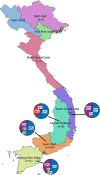Differential prevalence and geographic distribution of hepatitis C virus genotypes in acute and chronic hepatitis C patients in Vietnam
- PMID: 30865664
- PMCID: PMC6415813
- DOI: 10.1371/journal.pone.0212734
Differential prevalence and geographic distribution of hepatitis C virus genotypes in acute and chronic hepatitis C patients in Vietnam
Abstract
Background: The highest burden of disease from hepatitis C virus (HCV) is found in Southeast Asia, but our understanding of the epidemiology of infection in many heavily burdened countries is still limited. In particular, there is relatively little data on acute HCV infection, the outcome of which can be influenced by both viral and host genetics which differ within the region. We studied HCV genotype and IL28B gene polymorphism in a cohort of acute HCV-infected patients in Southern Vietnam alongside two other cohorts of chronic HCV-infected patients to better understand the epidemiology of HCV infection locally and inform the development of programs for therapy with the increasing availability of directly acting antiviral therapy (DAAs).
Methods: We analysed plasma samples from patients with acute and chronic HCV infection, including chronic HCV mono-infection and chronic Human Immunodeficiency Virus (HIV)-HCV coinfection, who enrolled in four epidemiological or clinical research studies. HCV infection was confirmed with RNA testing. The 5' UTR, core and NSB5 regions of HCV RNA positive samples were sequenced, and the genotype and subtype of the viral strains were determined. Host DNA from all HCV positive patients and age- and sex-matched non-HCV-infected control individuals were analysed for IL28B single nucleotide polymorphism (SNP) (rs12979860 and rs8099917). Geolocation of the patients were mapped using QGIS.
Results: 355 HCV antibody positive patients were analysed; 54.6% (194/355) and 46.4% (161/355) were acute and chronic infections, respectively. 50.4% (81/161) and 49.6.4% (80/161) of chronic infections had HCV mono-infection and HIV-HCV coinfection, respectively. 88.7% (315/355) and 10.1% (36/355) of the patients were from southern and central regions of Vietnam, respectively. 92.4% (328/355) of patients were HCV RNA positive, including 86.1% (167/194) acute and 100% (161/161) chronic infections. Genotype could be determined in 98.4% (322/328) patients. Genotypes 1 (56.5%; 182/322) and 6 (33.9%; 109/322) predominated. Genotype 1 including genotype 1a was significantly higher in HIV-HCV coinfected patients compared to acute HCV patients [43.8% (35/80) versus 20.5% (33/167)], (p = <0.001), while genotype 6 was significantly higher in chronic HCV mono-infected patients [(44.4% (36/81) versus 20.0% (16/80)] (p = < 0.004) compared to HIV-HCV coinfected patients. The prevalence of IL28B SNP (rs12979860) homozygous CC was 86.46% (83/96) in control individuals and was significantly higher in acutely-infected compared to chronically-infected patients [93.2 (82/88) versus 76.1% (35/46)] (p = < 0.005).
Conclusion: HCV genotype 6 is highly prevalent in Vietnam and the high prevalence in treatment naïve chronic HCV patients may results from poor spontaneous clearance of acute HCV infection with genotype 6.
Conflict of interest statement
This study was partly funded by Roche molecular diagnostics, the employer of Gabrielle M. Heilek. Two authors, Karen Saylors and Nathan Wolfe (part of the group authorship) are affiliated to Metabiota. There are no patents, products in development or marketed products to declare. This does not alter our adherence to all the PLOS ONE policies on sharing data and materials, as detailed online in the guide for authors.
Figures



Similar articles
-
Both Hepatitis C Virus-Specific T Cell Responses and IL28B rs12979860 Single-Nucleotide Polymorphism Genotype Influence Antihepatitis C Virus Treatment Outcome in Patients with Chronic Hepatitis C.J Interferon Cytokine Res. 2017 Jun;37(6):278-286. doi: 10.1089/jir.2016.0078. Epub 2017 Apr 25. J Interferon Cytokine Res. 2017. PMID: 28440692
-
Genetic polymorphisms of IL28b gene as predictors of response to dual therapy in genotypes 1 and 4-HCV and HIV/HCV-infected patients.New Microbiol. 2015 Oct;38(4):499-509. Epub 2015 Oct 20. New Microbiol. 2015. PMID: 26485009
-
IL28B gene polymorphism rs12979860, but not rs8099917, contributes to the occurrence of chronic HCV infection in Uruguayan patients.Virol J. 2018 Mar 2;15(1):40. doi: 10.1186/s12985-018-0946-2. Virol J. 2018. PMID: 29499724 Free PMC article.
-
IL28B polymorphism (rs12979860) associated with clearance of HCV infection in Poland: systematic review of its prevalence in chronic hepatitis C patients and general population frequency.Pharmacol Rep. 2015 Apr;67(2):260-6. doi: 10.1016/j.pharep.2014.10.006. Epub 2014 Oct 23. Pharmacol Rep. 2015. PMID: 25712648
-
Like a Rolling Stone? A Review on Spontaneous Clearance of Hepatitis C Virus Infection.Viruses. 2024 Aug 30;16(9):1386. doi: 10.3390/v16091386. Viruses. 2024. PMID: 39339862 Free PMC article. Review.
Cited by
-
Effectiveness of sofosbuvir based direct-acting antiviral regimens for chronic hepatitis C virus genotype 6 patients: Real-world experience in Vietnam.PLoS One. 2020 May 20;15(5):e0233446. doi: 10.1371/journal.pone.0233446. eCollection 2020. PLoS One. 2020. PMID: 32433676 Free PMC article.
-
Immune system control of hepatitis C virus infection.Curr Opin Virol. 2021 Feb;46:36-44. doi: 10.1016/j.coviro.2020.10.002. Epub 2020 Nov 1. Curr Opin Virol. 2021. PMID: 33137689 Free PMC article. Review.
-
High Cure Rates for Hepatitis C Virus Genotype 6 in Advanced Liver Fibrosis With 12 Weeks Sofosbuvir and Daclatasvir: The Vietnam SEARCH Study.Open Forum Infect Dis. 2021 Jun 9;8(7):ofab267. doi: 10.1093/ofid/ofab267. eCollection 2021 Jul. Open Forum Infect Dis. 2021. PMID: 34337093 Free PMC article.
-
Distribution pattern, molecular transmission networks, and phylodynamic of hepatitis C virus in China.PLoS One. 2023 Dec 21;18(12):e0296053. doi: 10.1371/journal.pone.0296053. eCollection 2023. PLoS One. 2023. PMID: 38128044 Free PMC article.
-
HCV RNA Quantification by a Domestic Commercial Assay: A Case Study among People Who Inject Drugs in Vietnam.Diagnostics (Basel). 2023 Nov 16;13(22):3456. doi: 10.3390/diagnostics13223456. Diagnostics (Basel). 2023. PMID: 37998592 Free PMC article.
References
-
- Organization WH: Global report on access to hepatitis C treatment. Focus on overcoming barriers. 2016, October(WHO/HIV/2016.20).

